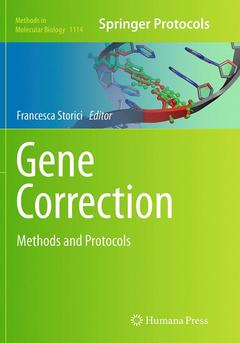Description
Gene Correction, Softcover reprint of the original 1st ed. 2014
Methods and Protocols
Methods in Molecular Biology Series, Vol. 1114
Language: EnglishApproximative price 116.04 €
Subject to availability at the publisher.
Add to cartSupport: Print on demand
463 p. · 17.8x25.4 cm · Hardback
Description
/li>Contents
/li>Comment
/li>
Gene correction is a technology that gives us the tools for both repairing and mutating DNA, for discovering gene functions and for engineering new genetic variants. Gene Correction: Methods and Protocols provides a user friendly, detailed and up-to-date collection of strategies and methodologies utilized for generating specific sequence changes in the DNA of cells in the laboratory, while also tackling the major problems that the field of gene correction faces. This volume brings together many experts in the field of gene correction to disclose a wide and varied array of specific gene correction protocols for engineering mutations in DNA, for delivering correcting DNA to target cells, and for improving the accuracy and safety of the gene correction process. Written in the successful Methods in Molecular Biology series format, chapters include introductions to their respective topics, lists of the necessary materials and reagents, step-by-step, readily reproducible protocols, and notes on troubleshooting and avoiding known pitfalls.
Authoritative and easily accessible, Gene Correction: Methods and Protocols seeks to serve scientists of all backgrounds interested in the area of gene targeting/recombination/therapy.
RecTEPsy Mediated Recombineering in Pseudomonas syringae.- Genome Manipulations with Bacterial Recombineering and Site-Specific Integration in Drosophila.- Multiple Genetic Manipulations of DT40 Cell Line.- Gene Targeting of Human Pluripotent Stem Cells by Homologous Recombination.- Methods for the Assessment of ssODN-Mediated Gene Correction Frequencies in Muscle Cells.- Small Fragment Homologous Replacement (SFHR): Sequence-Specific Modification of Fenomic DNA in Eukaryotic Cells by Small DNA Fragments.- Preparation and Application of Triple Helix Forming Oligonucleotides and Single Strand Oligonucleotide Donors for Gene Correction.- Triplex-Mediated Genome Targeting and Editing.- Targeting piggyBac Transposon Integrations in the Human Genome.- Gene Targeting in Human Induced Pluripotent Stem Cells with Adenoviral Vectors.- Enhanced Gene Targeting of Adult and Pluripotent Stem Cells Using Evolved Adeno-Associated Virus.- Lentiviral Vectors Encoding Zinc-Finger Nucleases Specific for the Model Target Locus HPRT1.- Designing and Testing the Activities of TAL Effector Nucleases.- A Bacterial One-Hybrid System to Isolate Homing Endonuclease Variants with Altered DNA Target Specificities.- Design and Analysis of Site-Specific Single-Strand Nicking Endonucleases for Gene Correction.- CRISPR-Cas Mediated Targeted Genome Editing in Human Cells.- RNA-Guided Genome Editing of Mammalian Cells.- Nuclease-Mediated Double Strand Break (DSB) Enhancement of Small Fragment Homologous Recombination (SFHR) Gene Modification in Human Induced Pluripotent Stem Cells (hiPSCs).- AAV-Mediated Gene Editing via Double-Strand Break Repair.- Genetic Modification Stimulated by the Induction of a Site-Specific Break Distant from the Locus of Correction in Haploid and Diploid Yeast Saccharomyces cerevisiae.- A Southern Blot Protocol to Detect Chimeric Nuclease-Mediated Gene Repair.- High-Throughput Cellular Screening of Engineered Nuclease Activity Using the Single-Strand Annealing Assay and Luciferase Reporter.- An Unbiased Method for Detection of Genome-Wide Off Target Effects in Cell Lines Treated with Zinc Finger Nucleases.- Identification of Off-Target Cleavage Sites of Zinc Finger Nucleases and TAL Effector Nucleases Using Predictive Models.- Method for Retinal Gene Repair in Neonatal Mouse.- In utero Delivery of Oligodeoxynucleotides for Gene Correction.- Portal Vein Delivery of Viral Vectors for Gene Therapy for Hemophilia.- Gene Correction of Induced Pluripotent Stem Cells Derived from a Murine Model of X-Linked Chronic Granulomatous Disorder.- Efficient Transduction of Hematopoietic Stem Cells and its Potential for Gene Correction of Hematopoietic Diseases.





